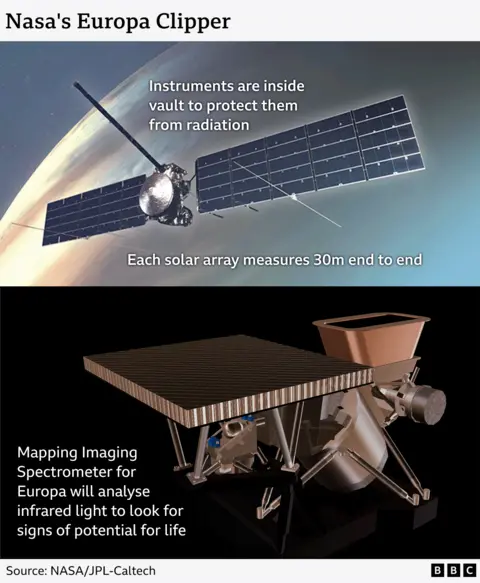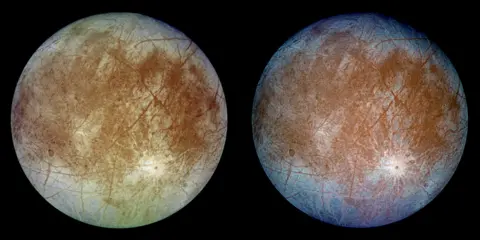 Getty Images
Getty ImagesIn a few hours, a spacecraft is scheduled to blast off from Florida in search of signs of alien life.
Her destination is Europa, a very mysterious moon orbiting the distant planet Jupiter.
It is possible that beneath its icy surface is a vast ocean containing twice the amount of water found on Earth.
The Europa Clipper spacecraft will chase a European mission that left last year, but using a cosmic backbone, it will overtake it and arrive first.
That won’t happen until 2030, but what he discovered could change what we know about life in our solar system.
A moon five times brighter than our moon
After years in the making, the launch of the Europa Clipper was postponed at the last minute after Hurricane Milton struck Florida this week.
The spacecraft was moved inland for shelter, but after inspecting the launch pad at Cape Canaveral for damage, engineers gave the green light for liftoff at 1206 local time (1706 GMT) on October 14.
“If we discover life far from the Sun, it would imply a separate origin for life on Earth,” says Mark Fox-Powell, a planetary microbiologist at the Open University.
“This is very important, because if this happened twice in our solar system, it could mean that life became really common,” he says.
Europa is located 628 million kilometers from Earth, which is slightly larger than our Moon, but that is where the similarity ends.
If it were in our sky, it would be five times brighter because the water ice would reflect more sunlight.
Its ice crust is up to 25 kilometers thick, and there may be a vast ocean of salt water. There may also be chemicals that make up the simple components of life.

Scientists first realized that Europa might support life in the 1970s when they saw water ice through a telescope in Arizona.
The Voyager 1 and 2 spacecraft took the first close-up images, and then in 1995, NASA’s Galileo spacecraft flew by Europa and captured some very puzzling images. They showed a surface full of dark reddish-brown cracks; Fractures that may contain salts and sulfur compounds that may support life.
The James Webb Telescope has since captured images of what may be plumes of water ejected 100 miles (160 kilometers) above the moon’s surface.
But none of those missions got close enough to Europa long enough to really understand it.
Flying through columns of water
Scientists now hope that instruments on NASA’s Clipper spacecraft will be able to map almost the entire moon, as well as collect dust particles and fly through water columns.
Brittney Schmidt, an associate professor of Earth and atmospheric sciences at Cornell University in the US, helped design a laser on board that can see through ice.
 NASA/JPL-Caltech/SETI Institute
NASA/JPL-Caltech/SETI Institute“I’m very passionate about understanding the plumbing of Europe. Where’s the water? Europa has the icy version of subduction zones and magma chambers and tectonics on Earth, and we’re going to try to see those areas and map them,” she says.
Its instrument, called Reason, was tested in Antarctica.
But unlike Earth, all instruments on Clipper will be exposed to huge amounts of radiation, which Professor Schmidt says is a “major concern.”
The spacecraft is supposed to fly by Europa about 50 times, and each time, it will be blasted with radiation equivalent to a million X-rays.
“Most electronic devices are in a heavily shielded vault to prevent radiation,” Professor Schmidt explains.
The spaceship is the largest ever built to visit a planet, and it has a long journey ahead of it. The spacecraft will travel 1.8 billion miles, orbiting Earth and Mars and propelling itself toward Jupiter in what is called a slingshot effect.

It can’t carry enough fuel to power itself all the way on its own, so it will depend on Earth’s momentum and Mars’ gravity.
It will overtake JUICE, the European Space Agency’s spacecraft that will also visit Europa on its way to another moon of Jupiter called Ganymede.
Once Clipper approaches Europa in 2030, it will fire up its engines again to carefully maneuver into the correct orbit.
 NASA/JPL/DLR
NASA/JPL/DLRSpace scientists are very cautious when talking about the chances of discovering life. They do not expect to find human-like organisms or animals
“We’re looking for habitability and we need four things: liquid water, a heat source, and organic matter. Finally, these three ingredients have to be stable over a long enough period of time for something to happen.”
They hope that if they can better understand the surface of the ice, they will know where to land the rover on a future mission.
This flight will be supervised by an international team of scientists with NASA, the Jet Propulsion Laboratory and the Johns Hopkins Applied Physics Laboratory.
At a time when space launches occur almost every week, this mission promises something different, suggests Professor Fox Powell.
“There’s no winning. It’s about exploration and curiosity, and pushing back the boundaries of our knowledge of our place in the universe.

“Devoted student. Bacon advocate. Beer scholar. Troublemaker. Falls down a lot. Typical coffee enthusiast.”


